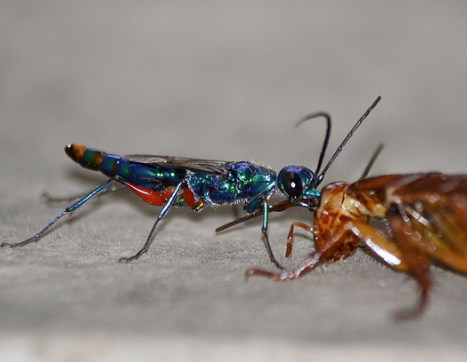Science News
Jewel Wasps Enslave Roaches with Targeted Sting
March 3, 2014
by Molly Michelson

Evolution is fricking amazing. Nowhere is this more evident than in parasites. They make use of and take over their hosts in remarkable ways—truly living up to “survival of the fittest.”
For example, regard the beautiful emerald jewel wasp. The wasp paralyzes and zombifies cockroaches to lay an egg on the abdomen of the unsuspecting insects. When the egg hatches, the wasp larva emerges and eventually eats its way into the belly of the roach. The larva then pupates inside the cockroach, building a cocoon and eventually emerging as a grown wasp.
Last year we described the unbelievable way the larva disinfects the cockroach belly before building its cocoon, and now, more crazy wasp news! To deliver a stinger-full of cockroach zombifying drugs, the jewel wasp is able to identify a specific brain target inside the cockroach’s head!
Brains, even cockroach-sized ones, are incredibly complicated, but somehow the jewel wasps are able to efficiently deliver their zombie drugs to roaches in just under a minute. So how do they do this?
Luckily, researchers at Ben-Gurion University are just as curious about these parasitic wasps as we are (maybe even moreso). They carefully studied the stinger that delivers the venom. They found that the stinger is two millimeters long, with sensitive dome-shaped bumps at the end.
After several experiments with normal cockroach brains and altered cockroach brains, the scientists theorize that the bumps on the stinger allow the jewel wasp to “feel” its way through the brain, targeting two specific spots where the venomous injection can create the zombified cockroach the wasp needs for its young’s nest.
(Carl Zimmer has more details on the experiments at National Geographic. For more gory details on the wasps’ hold over cockroaches, head over to Wired’s Absurd Creature of the Week for a fun read.)
Thank goodness you’re not a cockroach! The study was published last week in PLoS ONE.
Image: Deven Dadbhawala/Flickr